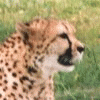
This is one of those long ago pictures of Drifter, my older son.
In this pic, you can see that he's the very lanky, teenager. In this case, it looks like he either laughing heartily or smiling one of those ear-to-ear smiles. In truth, it's neither; sorry to burst the Fun Bubble.
Cats exhibit what's called a Flehmen Response, much the same as horses and cattle and even candids, though it's not nearly as obvious as it is with some species.
For those of you familiar with snakes, you know that snakes (and a few other reptiles) stick out their tongue, wave it around a bit, and then take it back in and plug it into an organ in the roof of their mouths called a Jacobsen Organ. The "scent molecules" (for sake of better decription) are then analyzed by this organ, giving the snakes a sense of smell.
Cats (and a few other mammals) also have this same organ in the top of their mouths, and they use this in combination with their nasal sense of smell to essentially "hyper-analyze" scents. Obviously, there's a lot in a scent, and an animal having the ability to know what it all means is to their advantage. Here's how it works:
For a cat, there's two pores (or pits, depending on your school-of-thought) right behind the upper incisors (the teeth in the very front of the muzzle). The cat essentially flexes their face into somewhat of a grimace which opens up these pores, and then they can draw some scent into them. They can either draw it directly into the Jacobsen Organ, or they can get whatever scent it is - such as a scent-mark from another cat - onto their tongue, and then roll the tongue over the pores and take in the scent.
Obviously, until we learn how to speak Feline, we'll never know exactly what they can tell from all these scents. The theory is that scents are like a detailed sign, and the Flehmen Response is how the animals read that sign. So, we think they can tell an awful lot from these left-behind scents, such as the relative heath of the animal, its gender, its age, and if it's female, is it in season. There's probably even more to it all than just those things, but there's just no way to know.
So, this rather amusing pic of Drifter is actually Drifter doing a Flehmen, rather than smiling, even though I tend to smile when I see cats do this. There's actually a lot of truth to it being commonly called "The Stinky Face". In this case, Drifter is probably scenting a mark that he put there himself, but because it's one of those neat-o signs, he's gotta check it out, just to be sure. After all, one just can't take the chance of another kitty entering into one's turf! Can't have that!
I've got a few really good ones of Genesis doing a Stinky Face, and Bengals tend to be really dramatic about it. I think you'll find it amusing, so I'll do a follow-on post of one of those a bit later.
So here's Drifter with a smile...er...Flehmen. Don't forget to smile back!
This picture was taken somewhere around 16-May-02. It was taken with an old Kodak, consumer-grade digital camera (aka junk). I can't rattle of the specs, as this camera didn't record any of that info.
Disclaimer: I hate to have to put this on here, but the pic is copyright me. Please do not distribute, copy, alter, etc, without my permission. Having said all that, feel free to download and use it for your own inspiration.
In this pic, you can see that he's the very lanky, teenager. In this case, it looks like he either laughing heartily or smiling one of those ear-to-ear smiles. In truth, it's neither; sorry to burst the Fun Bubble.
Cats exhibit what's called a Flehmen Response, much the same as horses and cattle and even candids, though it's not nearly as obvious as it is with some species.
For those of you familiar with snakes, you know that snakes (and a few other reptiles) stick out their tongue, wave it around a bit, and then take it back in and plug it into an organ in the roof of their mouths called a Jacobsen Organ. The "scent molecules" (for sake of better decription) are then analyzed by this organ, giving the snakes a sense of smell.
Cats (and a few other mammals) also have this same organ in the top of their mouths, and they use this in combination with their nasal sense of smell to essentially "hyper-analyze" scents. Obviously, there's a lot in a scent, and an animal having the ability to know what it all means is to their advantage. Here's how it works:
For a cat, there's two pores (or pits, depending on your school-of-thought) right behind the upper incisors (the teeth in the very front of the muzzle). The cat essentially flexes their face into somewhat of a grimace which opens up these pores, and then they can draw some scent into them. They can either draw it directly into the Jacobsen Organ, or they can get whatever scent it is - such as a scent-mark from another cat - onto their tongue, and then roll the tongue over the pores and take in the scent.
Obviously, until we learn how to speak Feline, we'll never know exactly what they can tell from all these scents. The theory is that scents are like a detailed sign, and the Flehmen Response is how the animals read that sign. So, we think they can tell an awful lot from these left-behind scents, such as the relative heath of the animal, its gender, its age, and if it's female, is it in season. There's probably even more to it all than just those things, but there's just no way to know.
So, this rather amusing pic of Drifter is actually Drifter doing a Flehmen, rather than smiling, even though I tend to smile when I see cats do this. There's actually a lot of truth to it being commonly called "The Stinky Face". In this case, Drifter is probably scenting a mark that he put there himself, but because it's one of those neat-o signs, he's gotta check it out, just to be sure. After all, one just can't take the chance of another kitty entering into one's turf! Can't have that!
I've got a few really good ones of Genesis doing a Stinky Face, and Bengals tend to be really dramatic about it. I think you'll find it amusing, so I'll do a follow-on post of one of those a bit later.
So here's Drifter with a smile...er...Flehmen. Don't forget to smile back!
This picture was taken somewhere around 16-May-02. It was taken with an old Kodak, consumer-grade digital camera (aka junk). I can't rattle of the specs, as this camera didn't record any of that info.
Disclaimer: I hate to have to put this on here, but the pic is copyright me. Please do not distribute, copy, alter, etc, without my permission. Having said all that, feel free to download and use it for your own inspiration.
Category Photography / Animal related (non-anthro)
Species Feline (Other)
Size 1152 x 864px
File Size 213.9 kB
Cougars make me laugh. It's just so funny to watch their ears flip out sideways like wings, see the eye roll back into their heads, and then put on the total smilie-face and wave their noses around in the air.
Of course, tigers are funny to, especially with the tongue all hanging out and the snorting sounds. Whoever said big kitties aren't cute? :)
Of course, tigers are funny to, especially with the tongue all hanging out and the snorting sounds. Whoever said big kitties aren't cute? :)
You shoulda seen me when I took the picture! I was having trouble standing and taking the pic! :)
Drifter's usually not so pronounced about things, but age-wise, this was just about the time when he was mature, so all the scents were really starting to mean something. Now, he's a bit more mellow, and he doesn't always have his nose totally sticking into the air.
Drifter's usually not so pronounced about things, but age-wise, this was just about the time when he was mature, so all the scents were really starting to mean something. Now, he's a bit more mellow, and he doesn't always have his nose totally sticking into the air.
That's the biggest reason I hate dragging out the old pix: they all look so horrible comparing to the newer ones.
I got the Canon 10D in the early part of 2003, so everything after that isn't too bad, although there's some horrible ones with that too (but not nearly as many). :)
I just had a good laugh, digging this one up, so I had to post it. :)
I got the Canon 10D in the early part of 2003, so everything after that isn't too bad, although there's some horrible ones with that too (but not nearly as many). :)
I just had a good laugh, digging this one up, so I had to post it. :)
When you were gone, i stubled over a site where they talked about cougars. On this site, they entioned "the stinky face", but said nothing about what it was. Couldn't find anything while googeling it either, so thanks^^,
I always enjoy the trivia you add to the pictures you upload^^, It's teaching me a lot;)
I always enjoy the trivia you add to the pictures you upload^^, It's teaching me a lot;)
Drifter's my only cougar, but I have an Evil Spotted Thing (aka leopard) that I'm also pet to. :)
Dagger was the second cougar that ever possessed me, but he passed away in Dec '04. Shasta (who I'm now namesake to) was the first, back in the 80's.
All have a pic or two in the gallery. There's also quite a few of the other cats that I've worked with over the years, most of whom I'm very close to as well.
Dagger was the second cougar that ever possessed me, but he passed away in Dec '04. Shasta (who I'm now namesake to) was the first, back in the 80's.
All have a pic or two in the gallery. There's also quite a few of the other cats that I've worked with over the years, most of whom I'm very close to as well.
Cats have a very good sense of smell, so couple that with their innate curiosity, and there's a lot of humor value there.
Some cats really use scent, and others rely on more visual stuff. It's kinda a personality thing. Dagger, for example, would come all the way across the cage to visit me, but most of the time, he had to scent my hand or let me blow in his nose before he'd really ease up and start purring at me. Of course, Dagger didn't really trust people, so he had to be sure i was who he though I was before he'd open up and be friendly.
So scent for some cats is a really important thing. :)
Some cats really use scent, and others rely on more visual stuff. It's kinda a personality thing. Dagger, for example, would come all the way across the cage to visit me, but most of the time, he had to scent my hand or let me blow in his nose before he'd really ease up and start purring at me. Of course, Dagger didn't really trust people, so he had to be sure i was who he though I was before he'd open up and be friendly.
So scent for some cats is a really important thing. :)
Wow yeah makes sense being a wild animal gotta really use those instincts. My cat "Bengal" know's his name and responds to verbal commands (somewhat ;P if he feels like it) and loves his Cat Nip ;)
I wonder, do 'Big Cats' have the same reaction to cat nip as domesticated? There appears to be a psychological reaction to the smell, then a neurochemical relaxing effect once its been injested.
I wonder, do 'Big Cats' have the same reaction to cat nip as domesticated? There appears to be a psychological reaction to the smell, then a neurochemical relaxing effect once its been injested.
In truth, it's one of those cat-by-cat things. There's some domestic cats that could care less about cat nip, and others that it sends into orbit. With big cats, it's the same.
Mufasa (the lion in my gallery) goes totally goofy with catnip, and Macumba is a total weirdo anyway, so it makes him even worse. Java could care less, and Drifter snorts at it a few times, sneezes because he gets it all up his schnoz, and then walks away like it's boring. Nemesis, Macumba's dad, doesn't have any reaction to it either. Jasmine and Shaman seem to like it, but they don't really go goofy or anything with it.
I've had three domestics over time, and the Siamese was the once that couldn't care less. but the two black-and-whites (the "Sylvester Kitties") loved it and just got silly.
So truly, it's a cat-by-cat thing; some love it, some don't really care.
There's also a popular theory in the scientific/biologist community that it's a genetic thing. If the cats have a certain gene, then they like it and go all goofy, and if they don't, then it's just another interestingly scented stuff to investigate. It's affectionately called the "CatNip Gene" although most agree that it's not really a gene, but likely some kind of chemical-based sensitivity something like a pheromone-response. But there's not really a lot of testing that's been done, at least officially.
It also seems to be something that's entirely species dependent, hence the name "cat" nip. For us humans, CatNip tea is actually rather flavorful, but other than that, doesn't really do anything for us at all. Dogs either. But for cats... oh my!
In any case, I like giving CatNip to Macumba, as he really likes it. So if CatNip ever becomes classified as a drug, then I guess I'll be arrested for turning my son into a junkie and helping him with his habit. :) Oh, and CatNip Trafficking, as i usually buy it in the pound tubs.
Mufasa (the lion in my gallery) goes totally goofy with catnip, and Macumba is a total weirdo anyway, so it makes him even worse. Java could care less, and Drifter snorts at it a few times, sneezes because he gets it all up his schnoz, and then walks away like it's boring. Nemesis, Macumba's dad, doesn't have any reaction to it either. Jasmine and Shaman seem to like it, but they don't really go goofy or anything with it.
I've had three domestics over time, and the Siamese was the once that couldn't care less. but the two black-and-whites (the "Sylvester Kitties") loved it and just got silly.
So truly, it's a cat-by-cat thing; some love it, some don't really care.
There's also a popular theory in the scientific/biologist community that it's a genetic thing. If the cats have a certain gene, then they like it and go all goofy, and if they don't, then it's just another interestingly scented stuff to investigate. It's affectionately called the "CatNip Gene" although most agree that it's not really a gene, but likely some kind of chemical-based sensitivity something like a pheromone-response. But there's not really a lot of testing that's been done, at least officially.
It also seems to be something that's entirely species dependent, hence the name "cat" nip. For us humans, CatNip tea is actually rather flavorful, but other than that, doesn't really do anything for us at all. Dogs either. But for cats... oh my!
In any case, I like giving CatNip to Macumba, as he really likes it. So if CatNip ever becomes classified as a drug, then I guess I'll be arrested for turning my son into a junkie and helping him with his habit. :) Oh, and CatNip Trafficking, as i usually buy it in the pound tubs.
wow A WHOLE 16 OUNCES AT ONCE! :)
You gotta hook me up with that connection if the quality is good. My cat Bengal is 'picky' with his cat nip, it has to be fresh and of 'high' quality ;)
I always say Quality over Quantity with both Cannabis and its relative. That's cool how the two seperate breeds of 'cat' have very similar social and interpersonal communication behaviors.
My cat "Josephine" the domestic long hair who is entirely black doesn't like cat nip while Salvisa the blonde FEMALE tiger striped kitten is startin to get a 'taste' for it. I think what you were saying about a 'gene' being responsible would be very similar to what causes alcoholism in humans.
There is a neurological effect on humans, and other species which I can personally account for. It is a very 'minty' tea that produces a relaxing effect in all animals (this is why after Bengal goes 'nuts' and injest his fill he becomes heavily sedated and passes right out). I think it feels like a low dose of Valium (Diazepam) but would worrie about it being habbit forming, but so is Coffee and people who are complete Coffee Holics are very proud of their habbit ;)
You gotta hook me up with that connection if the quality is good. My cat Bengal is 'picky' with his cat nip, it has to be fresh and of 'high' quality ;)
I always say Quality over Quantity with both Cannabis and its relative. That's cool how the two seperate breeds of 'cat' have very similar social and interpersonal communication behaviors.
My cat "Josephine" the domestic long hair who is entirely black doesn't like cat nip while Salvisa the blonde FEMALE tiger striped kitten is startin to get a 'taste' for it. I think what you were saying about a 'gene' being responsible would be very similar to what causes alcoholism in humans.
There is a neurological effect on humans, and other species which I can personally account for. It is a very 'minty' tea that produces a relaxing effect in all animals (this is why after Bengal goes 'nuts' and injest his fill he becomes heavily sedated and passes right out). I think it feels like a low dose of Valium (Diazepam) but would worrie about it being habbit forming, but so is Coffee and people who are complete Coffee Holics are very proud of their habbit ;)
There were a couple of the better pet stores in St Augustine FL that sold it by the tub. It said it was "superior quality" and all that, but I don't think Mufasa or Macumba really cared.
Sometimes, even the pet section of WalMart has some of the good stuff in little tubs, but it seems to be hit-or-miss with them, as they don't seem to stock it regularly.
Sometimes, even the pet section of WalMart has some of the good stuff in little tubs, but it seems to be hit-or-miss with them, as they don't seem to stock it regularly.
yeh i've actually found that my local "Kroger" shopping center stocks a fairly decent quality product called "High Grown" catnip. Very nice looking/minty 'buds' of catnip with visible 'resin' on the flower. No stems/seeds and a decent value at $1.34 a ounce.
Also, I've found "Bad Kitty Catnip" via eBay some time ago and since then they've opened their own website (based in NY) and ship all over teh US. Its a bit cheaper at $1 an ounce and has a differn't smell/texture (like 'mids' vs 'highs') ... but enough about herbals for today ^_^ I'm smoking my own 'cat nip' right now ;)
Also, I've found "Bad Kitty Catnip" via eBay some time ago and since then they've opened their own website (based in NY) and ship all over teh US. Its a bit cheaper at $1 an ounce and has a differn't smell/texture (like 'mids' vs 'highs') ... but enough about herbals for today ^_^ I'm smoking my own 'cat nip' right now ;)
OMG I found so much cat nip info today... let me post the highlights...
How to make catnip tea (possible ADD/ADHD treatment?)
To make yourself a truly effective nightcap, simply bring 1-1/2 cups of water to a boil. Remove from heat and add 1 tsp. of preferably the fresh cut herb or else 1 tsp. of the dried material and let steep for about 20 minutes until lukewarm before drinking. Honey may be added if desired. An Old Amish Herbs remedy called Night Nip works pretty well, too, for insomnia. Three capsules before retiring is suggested. The tea is also very good for reducing fevers, the miseries of hay fever, and nausea. A small cup of warm catnip tea sweetened with honey is good for calming hyperactive kids.
Catnip is settling to the stomach, sedative, and, since it powerfully stimulates sweating, fever reducing. Its pleasant taste and gentle action make it suitable for colds, flu, and fever in children, especially when it is mixed with elderflower and honey. Catnip is markedly antiflatulent, settling indigestion and colic, and is also useful in treating headaches related to digestive problems. A tincture makes a good friction rub for rheumatic and arthritic joints, and, as an ointment, treats hemorrhoids.
And specifically about the chemistry from an eBay add no less lol
The chemistry of catnip
Although no one knows exactly what happens in the cat's brain, it is known that the chemical nepetalactone in catnip triggers the response, kicking off a stereotypical pattern in cats that are sensitive to the chemical. The catnip reaction is inherited in an autosomal dominant gene. Up to a third of adult cats, in which the gene is not present, are totally unaffected by catnip. Kittens under 3 months of age do not usually react to catnip, either.
How to make catnip tea (possible ADD/ADHD treatment?)
To make yourself a truly effective nightcap, simply bring 1-1/2 cups of water to a boil. Remove from heat and add 1 tsp. of preferably the fresh cut herb or else 1 tsp. of the dried material and let steep for about 20 minutes until lukewarm before drinking. Honey may be added if desired. An Old Amish Herbs remedy called Night Nip works pretty well, too, for insomnia. Three capsules before retiring is suggested. The tea is also very good for reducing fevers, the miseries of hay fever, and nausea. A small cup of warm catnip tea sweetened with honey is good for calming hyperactive kids.
Catnip is settling to the stomach, sedative, and, since it powerfully stimulates sweating, fever reducing. Its pleasant taste and gentle action make it suitable for colds, flu, and fever in children, especially when it is mixed with elderflower and honey. Catnip is markedly antiflatulent, settling indigestion and colic, and is also useful in treating headaches related to digestive problems. A tincture makes a good friction rub for rheumatic and arthritic joints, and, as an ointment, treats hemorrhoids.
And specifically about the chemistry from an eBay add no less lol
The chemistry of catnip
Although no one knows exactly what happens in the cat's brain, it is known that the chemical nepetalactone in catnip triggers the response, kicking off a stereotypical pattern in cats that are sensitive to the chemical. The catnip reaction is inherited in an autosomal dominant gene. Up to a third of adult cats, in which the gene is not present, are totally unaffected by catnip. Kittens under 3 months of age do not usually react to catnip, either.
"Although no one knows exactly what happens in the cat's brain, it is known that the chemical nepetalactone in catnip triggers the response, kicking off a stereotypical pattern in cats that are sensitive to the chemical. The catnip reaction is inherited in an autosomal dominant gene. Up to a third of adult cats, in which the gene is not present, are totally unaffected by catnip. Kittens under 3 months of age do not usually react to catnip, either."
yeh but also the fact that science has found one of the active naturally occuring compounds that creates the psychoactive effect, and its not soley isolated to cats. Cat nip tea could be a possible ADD/ADHD treatment as it's been used to "Calm hyperactive children" ;) Toldya its kinda like a low dose of valium ;)
also, here's a picture of the molecule:
http://z.about.com/d/chemistry/1/0/D/2/nepeta.gif
found a bunch of info at about.com:
http://chemistry.about.com/library/...../aa103001a.htm
"Nepetalactone Chemistry
Nepetalactone is a terpene composed of two isoprene units, with a total of ten carbons. Its chemical structure is similar to that of the valepotriates derived from the herb valerian, which is a mild central nervous system sedative (or stimulant to some persons). "
http://z.about.com/d/chemistry/1/0/D/2/nepeta.gif
found a bunch of info at about.com:
http://chemistry.about.com/library/...../aa103001a.htm
"Nepetalactone Chemistry
Nepetalactone is a terpene composed of two isoprene units, with a total of ten carbons. Its chemical structure is similar to that of the valepotriates derived from the herb valerian, which is a mild central nervous system sedative (or stimulant to some persons). "
Cats have the most impressive teeth, don'cha think?
There was a wolf (he died a few years back now) and he was a monster! I'd always thought cats had the largest canines of the carnivores, but Nakiska had them all beat!
Of course, if you compare the Clouded Leopard to anything else, the words "Mini-Smiledon" will come into your mind. :) Cloudeds have really huge canines.
There was a wolf (he died a few years back now) and he was a monster! I'd always thought cats had the largest canines of the carnivores, but Nakiska had them all beat!
Of course, if you compare the Clouded Leopard to anything else, the words "Mini-Smiledon" will come into your mind. :) Cloudeds have really huge canines.
Leopards are fun, in their own way. They're very difficult to work with because they're so fiercely independent.
If you work with them from the time they're little (like i have with Macumba) then it's a lot different; you bond with them, which makes a really special friendship.
If you're not their Chosen One, then it takes a grand lot of patience and time to gain their trust, but it's not impossible. As it's been said: "You make friends with a leopard, and you've really accomplished something.". That's very true. Jaguars are essentially the same as leopards in that respect, though I've done very little work with jag's.
If you work with them from the time they're little (like i have with Macumba) then it's a lot different; you bond with them, which makes a really special friendship.
If you're not their Chosen One, then it takes a grand lot of patience and time to gain their trust, but it's not impossible. As it's been said: "You make friends with a leopard, and you've really accomplished something.". That's very true. Jaguars are essentially the same as leopards in that respect, though I've done very little work with jag's.
One suggestion I'd have for you is to look around your local area and see if there's any privately run wildlife facilities. If so, very often, they depend on volunteer help to make everything happen. So if you find a facility near you, contact them and see if they need volunteers.
OH! i have always known that face had to do with smell...i have owned domestic cats my whole life and have a very close relationship with ALL of them, and i have always observed them very closley to try and understand the 'body language' or sounds of each of my cats so i can communicate with them individually by mimmicing their personal sounds/actions instead of just a general 'kitty kitty kitty'.....and i have always noticed that whenever they have smelled somthing on a bush outside,ect they would stop and open their mouths and look around with this funny face- When i was younger i thought maybe they just had a 'bad' smell or somthing hehe...but when i got older and had my own apartment so that i could keep my cats inside with me-i started noticing they only did the mouth thing when they smelled an area that the other cats had been laying recently-or heaven forbid-had peed on.
I had thought it was a way of smelling better-like a snake does-and you confirm this for me! Thanks so much for that info :D
I had thought it was a way of smelling better-like a snake does-and you confirm this for me! Thanks so much for that info :D
You're very welcome. I've been around a lot of big cats in my life (now 23-years of them, and 25 of studyin') so I like to think I've learned a thing or two about them. Domestics aren't so different. Bottom line, I love to share, tho I tend to get babbling a bit more often than not. :)
One of the things I've found as that as the "American Cat" most of the zoos across the US don't feather them, as they like the more "exotic" animals, like tigers, that are more dramatic and popular.
I've discovered while traveling around the world that cougars are fairly common in other country's zoos, which I was happy to see. Of course, by the same perspective, the cougar of the Americas is "exotic" there, and so much more interesting to them and their zoo-goers.
So, I guess it's always about perspective. For me, I'll probably always bleed cougar blood. :)
I've discovered while traveling around the world that cougars are fairly common in other country's zoos, which I was happy to see. Of course, by the same perspective, the cougar of the Americas is "exotic" there, and so much more interesting to them and their zoo-goers.
So, I guess it's always about perspective. For me, I'll probably always bleed cougar blood. :)
(Shasta grins) Well, "ferocious" is relative. If you look at the next Drifter pic, where he's draped over my shoulders, that's probably not a work that'll come to mind.
In truth, cats can be violent creatures; it's just in their nature, as that's how they survive in the wild, but they also have their moments of calm serenity. I like those the best.
In truth, cats can be violent creatures; it's just in their nature, as that's how they survive in the wild, but they also have their moments of calm serenity. I like those the best.
Like most things, we always see the universe through the "eyes" of the beliefs and perceptions that we have of things. As we learn new things, or gain experience, we might come to view tings differently. I guess that's the really neat thing about life: we are always able to change our perspective. :)
(Shasta grins) Oddly enough, even with the types of foods that felines eat - they are true carnivores and cannot digest vegetable matter - they really don't have "bad breath". Most animals don't, although there are exceptions, such as chemical imbalances and malnourishment.
So you're right. :) No stinky-breath for the kitty!
So you're right. :) No stinky-breath for the kitty!
Drifter is one of the quietest kitties that I've worked with. He's a cougar, so he can purr, and does almost constantly when I'm with him, but even his purr is just a little rumble. He rarely chirps, though he always does when I first see him - which I like to think is him being happy to see me - and usually right at feeding time when I'm taking his food-bowl in for him. Then, that's usually rewarded with another happy-chirp. :)
To me, purring and chirping, and tiger "talk" and chuffs have always been sweet and cherished music to my ears. So in that respect, Drifter sings up the storm! :)
To me, purring and chirping, and tiger "talk" and chuffs have always been sweet and cherished music to my ears. So in that respect, Drifter sings up the storm! :)

 FA+
FA+
































Comments